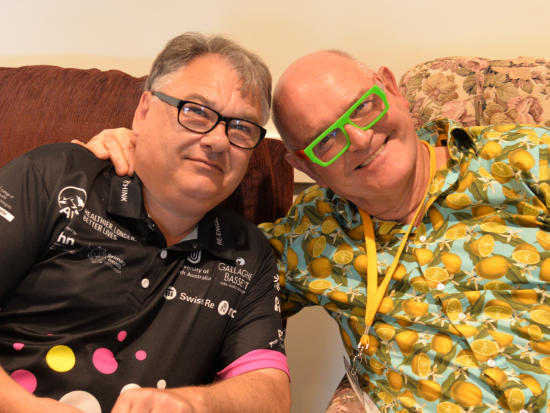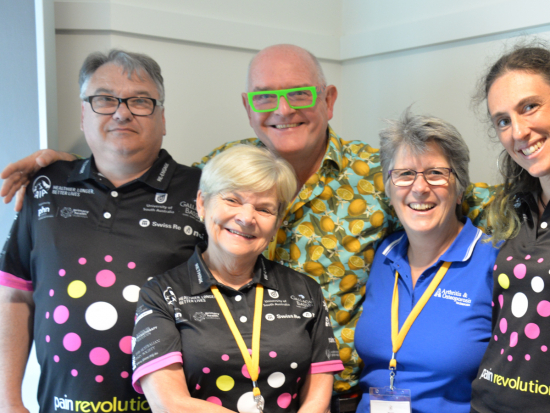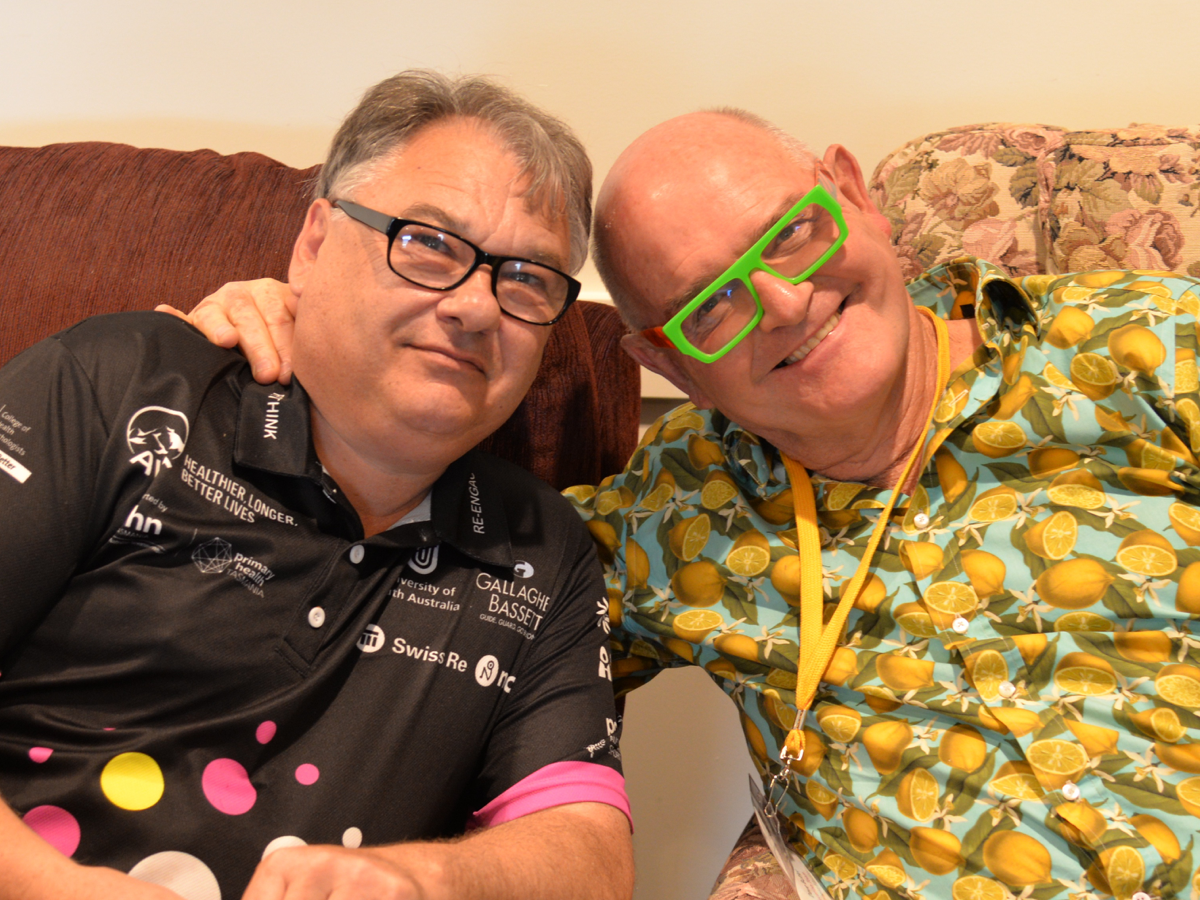Hello, my name is Trevor Barker, and I have experience living with persisting pain.

After more than 20 years of persisting back pain, my life took a positive turn when I learned and applied the positive principles of pain science in my life.
This is my story of how change was possible, even after many years of back pain and disability. I thought I was destined for a nursing home, and now I enjoy a full and active life.
Perhaps my story can spark something for you to get curious about approaching persisting pain treatment differently.
On Pain and Danger
It was May 2018 when I heard David Butler talk about DIMs and SIMs for the first time.
DIM and SIM stand for “danger in me” and “safety in me”, respectively.
This was a new concept that summed up “how to do life differently”, which helped me make meaningful and positive changes in my life.
For me, applying DIMs and SIMs took my recovery from persisting back pain further than I ever thought possible.
Pain is a Protector
I had a lot to learn about pain before I could see a different perspective to the pain that was running my life.
Pain is a danger detector. This means that it isn’t always an accurate indication of damage to my body. Understanding that pain was the result of many “danger in me” messages helped me to change my lifestyle and routines. Most importantly, it drew my attention to the thoughts and beliefs I had that was amplifying this perceived danger.
Any time I noticed my body was trying to alert me to danger, I could take a step back from my usual patterns of stress and the expectations of pain associated with flare–ups. I learned to focus on ways to increase the “safety in me” messages I was receiving.
This process became easier over time and instilled a new and growing confidence as I began to see a steady reduction in the intensity of those flare-ups.
Dangers in Me (DIMs)

I started by writing an “I hate” list.
This gave me clues to what lay beneath the surface that could ignite “danger in me” fires. This list helped me reach out to caring friends and even seek counselling to unpack some of the more intense danger messages that were hidden in my personal traumas.
The more I recognized “danger in me” messages, the easier it became to focus on ways of maximizing the creative and liberating “safety in me” messages.
Before we get into the SIMs it’s important to recognize that the danger detectors have a vital role in saving us from serious trouble. Ignoring them when real danger is present is not at all helpful – DIMs are trying to protect after all.
You can read important medical information about pain and when seeking care is important in this post about red flag pain conditions.
Safety in Me (SIMs)

When the danger detection system is most sensitive, and pain becomes persistent, it’s time to activate SIMs to have some fun, and see how well SIMs can help you to reduce pain.
SIMs are actions and thoughts that build up an overall sense of safety and wellbeing.
In other words, it’s a “nice things I can do for me” list.
I used to think and act on a major DIM that went something like this: “Trevor, you need to rest. Lie down and put a heat pad on your sore, fragile, and damaged back”.
This was such a DIM because I now know that lying down for hours a day was a misplaced protective behavior – it wasn’t making me any safer or making my pain any better overall. Of course, sometimes you need to rest, but my DIM was keeping me sedentary far too often, and for far too long.
My SIM to counter this DIM was to say to myself “Trevor, moving is safe, it is good for you, and you will not do more tissue damage by steadily increasing movement.”
I backed up this thinking by getting out and walking, by stretching, by doing regular hydrotherapy in the pool, and by listening to physiotherapists who knew me and were affirming that movement was safe and not causing further tissue damage.
Just about everything I do now in maintaining my recovery from persistent pain is a SIM.
These SIMs address the psychological and social side of my overall wellbeing.
The better I get at focusing on SIMs, the less room there is for DIMs in my life, and the more fun I have.
DIM/SIM Therapy in Practice
For what it’s worth these are my SIMs. Maybe some will work for you too!
- Making a coffee and sitting in my sunroom as a simple, but delicious, start to the day
- Going out into the garden and picking a rose, smelling it and taking it inside to brighten up my home. One SIM can lead to many others!
- Writing
- Going to my shed and doing woodwork
- Walking to the local football club and having a meal every Thursday night with the locals
- Volunteering and helping others in my local community
- Going to church
- Walking up to the Post Office to pick up the mail and have a chat
- Playing my flute and listening to music
- Working
- Visiting friends
- Going for a morning walk as the sun rises and listening to the birds
- Going bowling
- Skyping with my family
- Visiting family and taking my grandchildren to the park, the zoo or rock climbing
- Caring for others, encouraging them and enjoying positive relationships
- Laughing, hugs
- Taking photos of my favorite places and people,
- Looking at photos of fun times and reading stories with my grandchildren
Life-Changing Pain Education

After 20 years of persistent pain where I saw myself as disabled and had no hope for recovery, my life was dominated by DIMs. The list of SIMs I’ve just rattled off was nonexistent. I was isolated and stuck on a road that was truly bleak.
Today, my pain has faded to a distant memory.
Sure, sometimes it comes back – especially when I ignore my SIMs for a time. However, my new normal has come from using these SIMs to counter DIMs and retrain that once too–sensitive danger detection system.
My list of SIMs keeps me enjoying life, growing in confidence and freedom from pain to the point that there is little room for any DIMs at all.
I hope my experience with DIMs and SIMs can help you to see the possibilities for change that you have too!
Regards, Trevor Barker
Learn about the Protectometer
SIMs and DIMs are a central part of the “Protectometer”, a concept that enables you to measures your overall danger and safety balance at any given time, and find trends over time.
You can learn more about the Protectometer from NOIgroup in this video:
There is more information about DIMs and SIMs, and ways to apply this concept to your life in the Protectometer book, and the Protectometer app (IOS only).
The Protectometer is a useful way to understand how your pain can change with your activities and environment, and how this knowledge can help you to influence your experience of pain in your life.
Disclosure: David Butler is the author of Protectometer book and is an unpaid advisor to PainChats. Neither PainChats nor Trevor Barker receives any royalties from the sales of books or products through NOIgroup.



 Comfort, Safety and Helping Yourself Out of Pain
Comfort, Safety and Helping Yourself Out of Pain

Great work Trevor. I’ve forwarded this to several clients today. Your insight and experience is greatly valued.
This is encouraging. Thank you for sharing. I’d love to reduce my chronic back pain which is triggered by sitting or standing on the spot, by the approach you describe but my SIMS often include sitting ie:- meals out, watching a film, coffee with a friend so I feel it’s a cycle I can’t break.
Hi Esther,
Lissanthea here, I’m an editor for PainChats and a Physical Therapist.
That’s a tricky problem indeed and many people have similar problems. It’s difficult to give you personalized advice in this comment, but a good general idea for you might be to try using these principles in other activities first – like increasing activity in walking or trying some gentle exercises in standing – to help you get a bit more capacity before trying to do more sitting.
I hope that helps!